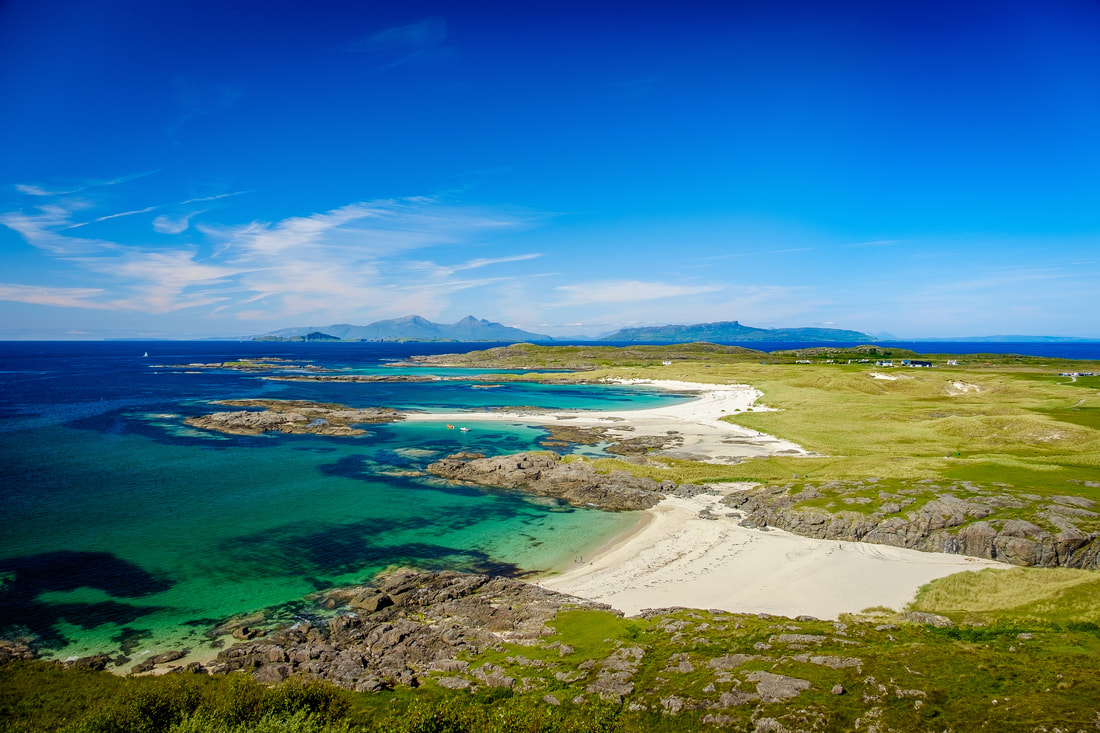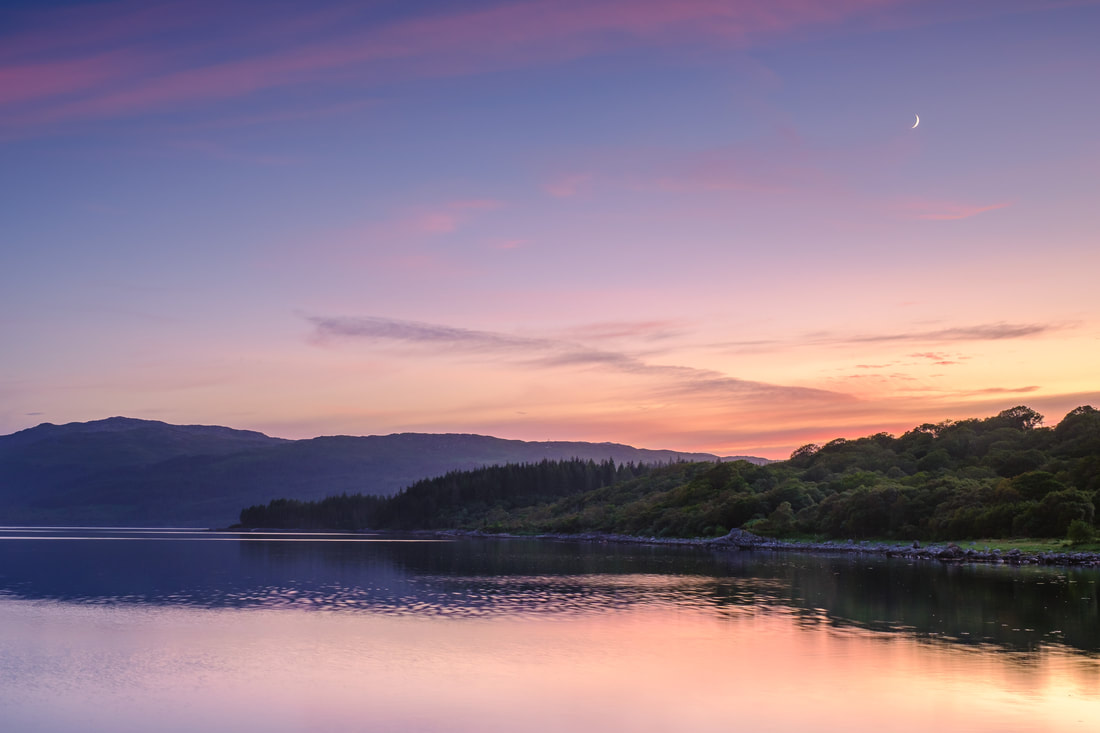|
Despite living on the Peninsula for several years now, it still often feels like it is a world away from the rest of the country and it is little wonder that summer brings a steady stream of visitors seeking to experience this beautiful, remote, and unspoilt corner of the Scottish Highlands. I often say to visitors that it has a bit of everything that Scotland has to offer, with rugged mountains, beautiful lochs and ancient woodlands, but it is its dramatic and stunning coastline that holds the biggest draw for me and features most in my photography Take this month’s image, which was shot on a beautifully sunny day in July out at Sanna, looking north across the bay to the Small Isles beyond. On days such as this, with bright sunlight overhead, the sea takes on an intense range of blue hues ranging from light blues of the shallow water to the dark blues of the deeper water, all caused by the way light interacts with the seawater.
You see, daylight is made up of many different visible colours, ranging from reds and oranges to blues and violets, with the reds and oranges having the longest wavelengths and the blues and violets having the shortest. As water molecules are better at absorbing light with longer wavelengths, they absorb much of the red, orange, yellow and green light. The bluer colours, with shorter wavelengths, are less likely to be absorbed and so are reflected by the white sand on the seabed to give the sea its blue hues. In shallow water, there are fewer water molecules to absorb the red, orange, yellow and green light, so more of it reaches the seabed to be reflected with the blues and violets and give either clear or slightly blue water. However, the deeper the water becomes, the more the reds, oranges, yellows and greens are absorbed and the deeper blue the colour of the water becomes, until you reach the point where no visible light can reach the seabed and the water becomes completely dark. I find something quite captivating about the aquatic blue hues of the sea at places such as Sanna and I’m sure that this is reflected in my affinity for water and for photographing the sea and the coastline. In fact, it has been documented that our affinity for water is reflected in our near-universal attraction to the colour blue and that we associate this colour with qualities like calm, openness, depth and wisdom. The link between the two has even been developed into something called “Blue Mind Science”, the study of aquatic environments’ health benefits that was first popularised by marine biologist Dr Wallace Nichols in his 2014 book, “Blue Mind”. Simply put, Blue Mind is a mildly meditative state that people fall into when they are near, in, under or on water and some of the physical and mental health benefits include:
So, if you’re seeing red, feeling angry, anxious, and stressed, then head to the coast for some “Blue Mindfulness”. I can highly recommend it.
4 Comments
It’s June and summer is finally upon us. This means milder weather and longer days, with the longest day of all taking place on 21 June, the day of the Summer Solstice. As the Sun sets so late and rises so early, it barely gets dark at this time of year. Indeed, this month’s image, which was taken shortly before 11:00 pm on a night close to the Summer Solstice, shows just how light it can be. I spent quite some time then, sitting on a small promontory facing west over Loch Sunart and watching the slimmest of crescent moons traverse the twilit sky as midnight approached. There sure is something magical about these light nights and it is little wonder that the summer solstice and midsummer have been celebrated for time immemorial This year, the summer solstice occurs on 21 June at 10:13 am. It is the exact moment when the North Pole is at its maximum tilt towards the Sun, when the Sun reaches its highest position in the sky and when the Sun rises at its closest to north-east and sets at its closest to north-west.
Although the summer solstice is a precise moment in time, many people refer to it as the “Longest Day” because it is the day when the number of hours of daylight are at their maximum and the number of hours of night are at their minimum. For instance, on 21 June this year, our sunrise here on the Peninsula will be at 4:27:36 am and our sunset will be at 10:22:23 pm, giving us 17 hours, 54 minutes and 47 seconds of daylight. While the summer solstice marks the astronomical start of our summer, it has traditionally been celebrated in Scotland as midsummer, the halfway point in the growing season and a time when people hoped for bountiful harvests. The celebrations began as a Celtic fire festival when bonfires would be used to bless crops and beasts. Animals would be walked around the fire in a sun-wise (clockwise) direction and torches would be lit from the main fire to then be carried around homes and fields, also in a sun-wise direction, to bless families and the crops. Also, people used to gather herbs at this time, and either scatter them into the fire to complete the ritual, wear them along with flowers to ward off evil spirits, or place them under their pillows as good luck charms to manifest good dreams. Birch branches were sometimes hung above doors for protection. This was also believed to be the best time to collect honey from beehives, which is why the first full moon in June was called the “honey moon”. Unsurprisingly, this became the traditional month for weddings. With the coming of Christianity, many pagan midsummer celebrations were moved to the feast of St John the Baptist on 24 June, with bonfires remaining central to them. People would light the bonfires on midsummer eve and then stay up until midnight to welcome in midsummer day. They continued to gather herbs and flowers to protect themselves from evil spirits and one of the most powerful plants was ‘chase-devil’, which is now called St John’s Wort. It was used in potions and woven into garlands because people believed that this would provide them with protection. Finally, herbalists continue to use St John’s Wort in medicines to this day. It contains many chemicals that act on messengers in the brain that regulate mood and there is some strong scientific evidence that it is effective for mild to moderate depression. |
AuthorHi, Archives
March 2024
Categories
All
|



